Koa Wood: What is it?
Acacia koa is a species of flowering tree in the pea family, Fabaceae. It is endemic to the Hawaiian Islands, where it is the second most common tree. The highest populations are on Hawaiʻi, Maui and Oʻahu. Its name in the Hawaiian language, koa, also means brave, bold, fearless, or warrior.
One of the most popular and prized Hawaiian woods for sale, Koa is a very special tropical hardwood.
Koa Lumber Data
| Scientific Name | Acacia Koa |
|---|---|
| Common Names | Acacia, Hawaiian Koa |
| Thickness Availability | 10/4, 12/4, 4/4, 5/4, 6/4, 8/4 |
| Commercial Availability in US | Low |
| Family | Fabaeceae |
| Genus | Acacia |
| Kingdom | PLantae |
| Region of Origin | Hawaii, North America, The Big Island, United States |
| CITES Appendix | No |
| IUCN Red List of Concern | No |
| Janka Rating | 1165 |
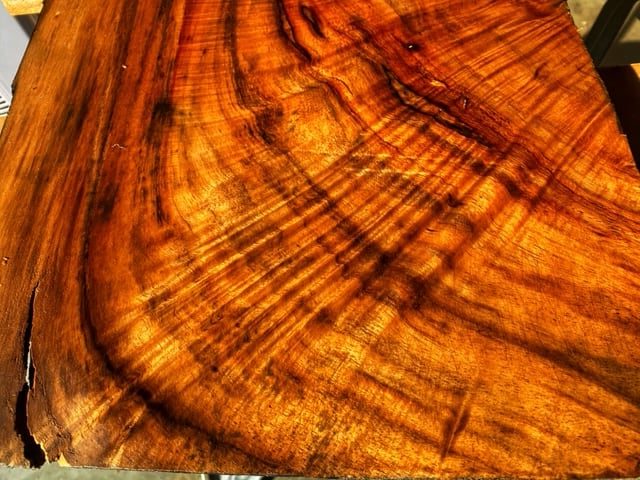
Technical Information
- Scientific name: Acacia Koa
- Alternative Names:
- Koawood, Hawaiian Koawood, Hawaiian Acacia,
- Region of Origin: The Hawaiian Islands (predominately the Big Island), United States
- Average Dried Weight: 37.5 LB/cubic foot
- Janka Hardness Rating: 1165
- Specific Gravity: .64
- IUCN Red List: No
- CITES wood: No
Why is Figured Koa Wood Expensive?
There are 3 reasons why figured Koa wood is expensive:
- Overall limited wood supply.
- Figure appears in a small percentage of Koa logs.
- There are few acceptable substitutes to Hawaiian Koa wood.
Koa exotic Hawaiian wood is prevalent throughout areas of Hawaii. However, laws control the harvest of Koawood trees. Generally speaking, healthy Koawood trees cannot be harvested. Thus, the supply of processed Hawaiian woods for sale is limited at most times.
Rare Figure
Additionally, only ten percent of koawood logs exhibit figured grain. As a result, intense competition among buyers creates high price points for limited supplies of figured Koa wood from Hawaii. Not surprisingly, figured varieties are extremely popular with:
- Luthiers (Guitar builders)
- Furniture Makers
- Ukulele builders
- Knife makers
Typically, when wood prices rise for a particular specie, buyers seek lower cost substitute species. Okoume, for example, has high chatoyance without the high cost associated with Hawaii’s Koa wood.
Interestingly, Koawood has few passable substitutes. Both Monkeypod and Parota are visually similar woods. However, neither wood has the prestige or branding of Koawood.
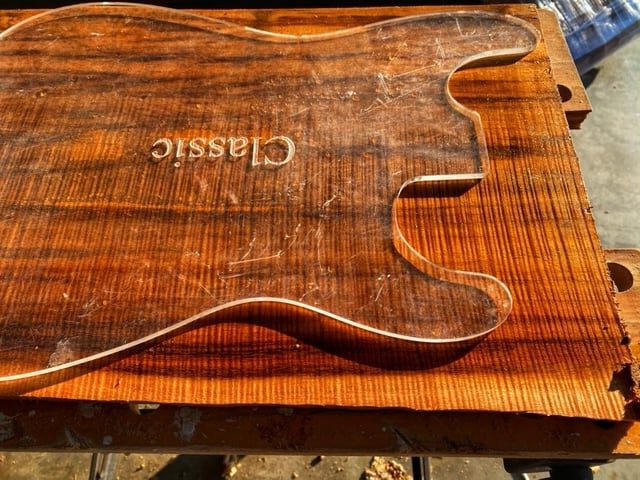
Why Is Koa Special?
Koa is a rare specie of hardwood endemic to the Big Island of Hawaii. Additionally, it is inextricably tied to Hawaiian culture and heritage. In my opinion, no other wood from Hawaii has closer emotional ties to its geography of origin.
Koa is known worldwide for three physical characteristics:
- Rich color and chatoyance
- Color depth is almost three dimensional.
- Unique grain texture
Significantly, it is listed as a wood of least concern by the IUCN. Accordingly, it is not considered endangered.
However, Hawaiian koa wood legislation restricts harvesting. Sawyers cannot cut trees at will. Rather, only dead or dying trees may be processed. Typically, severe storms damage trees in the Big Island. Thus, the supply of Koa wood for sale depends significantly on storm frequency.
Koa wood is known for the deep rich colors and varied grain patterns. Old growth trees contain the most figured lumber. The grain is interlocked, which often causes curly figuring. Koa, is a hard wood and has high crush resistance and shock absorbance.
source: KoaWood Ranch
What Does Koa mean?
So, translated into English, Koa means warrior. According to the Ulukau Hawaiian Dictionary, the first Hawaiian to English definition is:
1. nvs. Brave, bold, fearless, valiant; bravery, courage. Cf. hoʻonakoa, puʻipuʻi. Aʻo nō i ke koa, aʻo nō i ka holo (saying, Kel. 45), learn bravery, learn to run [be brave but prudent in war]. hoʻo.koa Brave; to cause bravery. (PPN toʻa.)
source: Ulukau Hawaiian Library
Military Connection Between Wood and War
King Kamehameha The Great was the first ruler of the Kingdom of Hawaii. However, prior to becoming King, he served in the Royal Court of his uncle, Kalaniʻōpuʻu. Significantly, one of his assigned religious responsibilities was the protection of the Hawaiian War God Kūkāʻilimoku.
Not surprisingly, his military expeditions involved both weapons and canoes crafted from Acacia. Accordingly, his warriors became identified with the Big Island wood and vice versa.
What Is It Used For?
Koawood has many uses in contemporary woodworking:
- Acoustic Guitar backs, sides and tops
- Electric guitar tops, bodies and necks
- Knife handles
- Gun grips
- Wood turnings
- Inlays
- Ukulele parts
- Koa wood rings
- Wood pen turnings
Typically, Acacia uses are limited to small parts and smaller volumes. However, its cost and limited availability discourages its use in larger projects.
For example, koa wood in Hawaii is rarely used for solid hardwood flooring, a material intensive application. Instead, plywood veneers and engineered flooring work well. Not surprisingly, they use a much lower percentage of Acacia per square foot of product.
In addition, Acacia is used in traditional Hawaiian canoe and wood paddle making. For a fascinating history of Polynesian sailing vessels, check out The Evolution of the Hawaiian Canoe by Herb Kawainui Kane. Starting in the 1070’s, Kane brought elements of Polynesian culture to the Mainland and beyond. A well respected maritime artist & historian, Kane passed away in 2011.
What is Figured Koa?
Figured Koawood is Acacia Koawood with more prominent grain pattern than typical koawood. Typically figure is assessed from the wood’s longitudinal face. According to its most basic definition, figured Acacia has a different grain-pattern appearance than a typical Acacia board. However, defining typical Acacia grain is also difficult!
Curly Koa
Curly Koa is figured koa containing burl & swirly grain patterns. The wavy grain stands out prominently, even when koa is unfinished. Curly Koa is found in less than 2% of Koa trees. Typically, koa wood grain is uniform. It’s definitely a rare wood.
Flamed Koa
Flamed Koa wood is a favorite tonewood of many luthiers of guitar, bass and ukulele. Essentially, flame figure is the same as curly figure. However, when koa’s figure is viewed from the flat-sawn side, it appears curly. When viewed from the quartersawn side, it looks flamed.
According to lumberman Rick Hearne:
“It can go from a light gold color to a rich purple color and pass through orange and scarlet along the way, even chocolate. It gets a chatoyancy to it that no other wood approaches. When you put an oil finish on koa, it fires up; it is just outrageously beautiful and it’s like a hologram when you walk by it. The picture changes. It looks like it has halogen light bulbs blazing out of it.”
source: Woodshop News
Figured Koawood takes several forms: Flamed, Curly and Crotch.
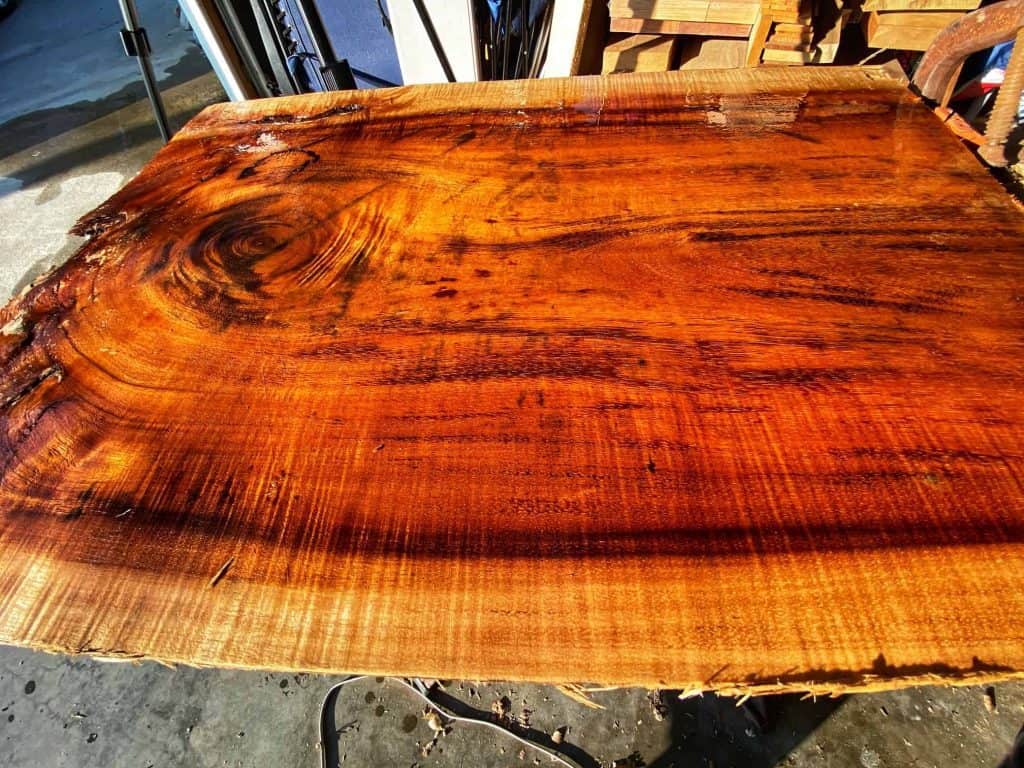
What Causes Figure in Koa Wood?
Despite many theories, we do not know why some koawood trees contain figure while most do not.
According to a 2017 study by the United States Forest Service researcher Shaneka Lawson:
The underlying factors determining amount and quality of figuring is not known. Forest Service scientists are just beginning research to solve the mystery.
source: US Forest Service Research and Development.
Significantly, Lawson conducted extensive biological research on Koawood. In additional, she analyzed genetic samples from both figured and non-figured Acacia-Koawood trees. As of 2017, no genetic predisposition to grain figure in Koawood is known.
However, Koa trees in higher elevations have more grain figure than those grown in lower elevations. Accordingly, soil composition or wind conditions may play a role.
What Does Koa Wood Sound Like?
Generally speaking, instrument makers are more interested in the acoustic properties of their woods than the appearance. Koa appears stunning. Additionally, it has unique sonic properties.
A dense tropical hardwood, koa blends midrange focus with extra top-end brightness and chime. … A tropical hardwood, koa’s tone blends the midrange of mahogany with the top end of maple. Due to its density, a new koa guitar tends to start out sounding a little bright and tight, somewhat like maple.
source: Taylor Guitars Hawaiian Koa (Taylor Guitars)
The Sound:Koa guitars might sound bright and tight off the shelf, and benefit from a good amount of ‘playing in. ‘ The more they’re played, the more the sound opens up. Tones become richer, sweeter and more resonant, with a rich low end and well-rounded sparkle overall
source: Know Your Tonewoods: Spotlight on Hawaiian Koa. (Thalia Capos)
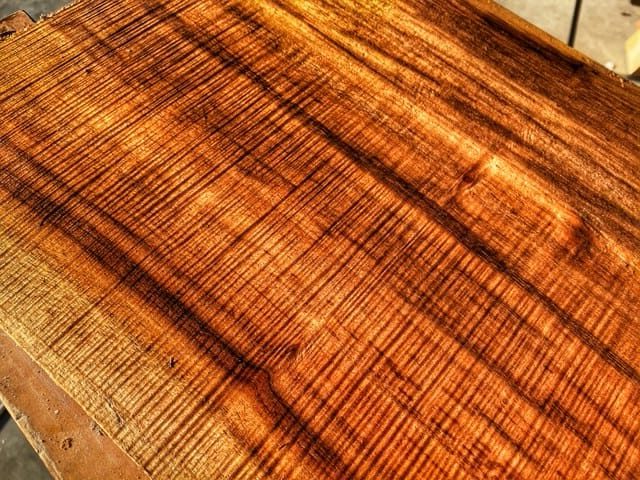
3 Things to Hate About Koa-wood
Finding desirable Koa wood for sale is difficult. Despite that, we do have Hawaiian Koa lumber for sale.
Yet, here I am bad-mouthing it.
However, it’s a tongue-in-cheek rant. Most accurately, our relationship with Hawaii’s Koa wood lumber is one of love and hate.
1. Koa Branding.
Koawood is unique because it has a spiritual association with Hawaiian culture. It makes people feel a certain way. Significantly, I cannot think of any other hardwood specie with that type of ingrained branding.
Koa wood from Hawaii makes people think of playing ukuleles, sipping drinks on the beach, Hawaiian history and culture.
Because of this unique specie branding, Acacia Koawood is treated with reverence. Reverence sometimes breeds arrogance among sellers.
The figured Koawood market is a sellers’ market. Perspective buyers are often forced to deal with unresponsive arrogant suppliers. Cash-ready lumber buyers are vetted by exotic wood dealers. It’s a unique phenomenon in the wood business.
Sawing Koa Lumber; A Sawmill’s Story
A small Koa sawmill posted their frustrations in dealing with Acacia wood on the Lumberjocks forum in 2015.
Gamesmanship and competitive pressures literally forced this sawmill out of business despite its optimal Hawaiian location. Additionally, this acacia producer vented online about both his suppliers and customers. Again, this rarely happens with other hardwood lumber species.
I’ve posted text from the thread below. Keep in mind that I do not know Joseph Jossem and cannot verify his claims. However, his account dovetails with my understanding of the cult of Koa.
Koa Wood Mill
I have been cutting and selling hardwoods since out of high school. I used to get alot of satisfaction selling and seeing others use the lumber in projects. Now 80% or more of lumber customers either want to haggle on price or complain and then haggle. The majority of them build to sell and make good money at it. No more of that for me everybody can cut there own damn lumber!
When I first started I also bought and resold a lot of koa lumber. Main thing I was sure to be polite never try to bargain and be happy with what I got. I guess those days are gone respect I think is the main thing and a lot lack it. Not sure where the mentality of trying to bargain everything down but in a full circle sustainable operation everybody has to pay up. So think about the next time you piss off your sawyer it might be the last time you get lumber.
think it has a lot to do with Hawaii also. If you look on cl and other places people want more $ then the item cost new. I often go above and beyond to help customers out guess the majority see it as a weakness.
Joseph Continues
Actually the lumber market is in really bad shape here now. All the past companies have raped the forests so much theres (sic) no more chances for the new companies coming up. federal departments haven’t been able to put a legal bid out since 2007. Now the companies that also caused the mess all of a sudden are instant tree huggers and blame others for the current market. You would figure with the most valuable wood in the world we would at least have a good koa source in this state. if you go to japan or others areas in the states they have more Hawaiian koa go figure.
Dave thanks but I haven’t had koa in 7 years. 7 years ago I tried to expand my lumber operation and started bidding logging jobs. With in a months time I lost all my vendors I was cut from koa sources and was kicked out of my warehouse. I went from a really good monthly income to nothing over night. Warehouse was broken into and road flares thrown inside 1 of my 2 dogs was poisoned Koa is a very dangerous business.
Best part is I knew I was on the right track when all the trouble started. I have adapted my business to survive with out koa. Now I get a good laugh watching everybody going after koa.
Source: Jossem, Joseph (“I Finally Quit” Lumberjocks.com https://www.lumberjocks.com/topics/74681)
2. Koa Pricing.
Even bland Hawaiian Koa lumber is expensive. Highly figured Koawood is extremely expensive. For reference, here is a link to Hearne Hardwoods Koawood for sale online. As of January 2020, I see some individual slabs priced at up to $19,000+!
Due to the high cost of Acacia Koawood, buyer expectations for the Hawaiian wood are high, across the board. Thus, buyer quality expectations often run against reality. Arguably, this is a seller communication issue.
3. Hawaiian Koa-lumber Manufacturing.
Much of the koa-wood we buy arrives poorly manufactured. Boards are not square, lots of wane with a generally sloppy appearance. In contrast, most of the mainland domestic hardwoods we buy such as red oak, maple and poplar arrive well manufactured, square with a uniform appearance.
There are 3 reasons why Koawood boards are rarely cut uniform.
First, unlike Poplar, every fiber of a Hawaiian Koa-tree is valuable wood. Thus, processors leave as much sell-able wood on the board as possible. Often, at the expensive of uniformity. Second, Acacia Koawood from Hawaii is in high demand. Thus, lumber availability is more important than presentation. Third, Acacia lumber processing is usually done on a small scale since the volumes are relatively small. Accordingly, Hawaiian woods are often processed on portable, low precision sawmilling equipment.
Koa Lumber For Sale in California
Hawaiian Koa wood is sometimes available for sale from the Big Island. However, you may be surprised to know that we supply Hawaiian Koa to the Big Island! Our koa ships from our Fontana, California location, 2542 miles away from the Big Island, as the crow flies. Even though the lumber originates from Hawaii, we send it back to the Big Island efficiently using USPS flat rate shipping.
When looking for quality koa suppliers many woodworkers first explore top-rated hardwood stores nearby. Then they read the Google My Business & Yelp reviews.
However, even if an excellent hardwood store is close-by, only a rare few provide Koa lumber for sale.
Accordingly, we deliver our stock of Koa lumber to where you are! Our lumber sales warehouse located on the US Mainland in Fontana, California. However, we ship Koawood & tonewoods all over the world. Thus, when searching for figured koa near me, we are nearby & can help, regardless of your shipping address.
Hawaiian Koa Figured Wood Slab For Sale
Here is one stunning example of Hawaiian wood that is currently for sale nearby on eBay (as of June 25, 2022). The grain & figure of this Hawaiian slab speaks for itself.
Additionally, we have hundreds of unique pieces of Hawaiian Koa lumber in stock and for sale in our Fontana, Warehouse. If this slab is sold by the time you’re reading this, browse our eBay store for more Hawaiian wood offerings. We list new koa wood for sale on a regular basis.
Why We Sell Hawaiian Koa Wood
Despite the challenges of sourcing quality Koawood, we are active buyers. The reason we sell Acacia lumber is that we source some incredible one-of-a-kind figured Koa wood. Of course, it’s not easy, but we’re always seeking rare and unique cuts of flame, figured and curly koawood and non-instrument wood.
Our current online Koawood inventory for sale is on our eBay store here:

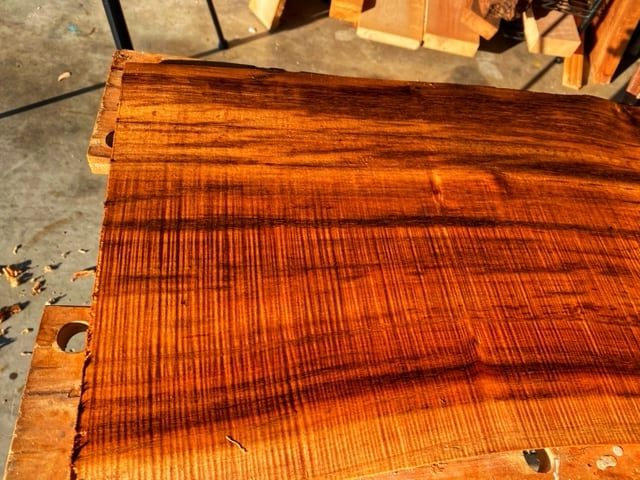
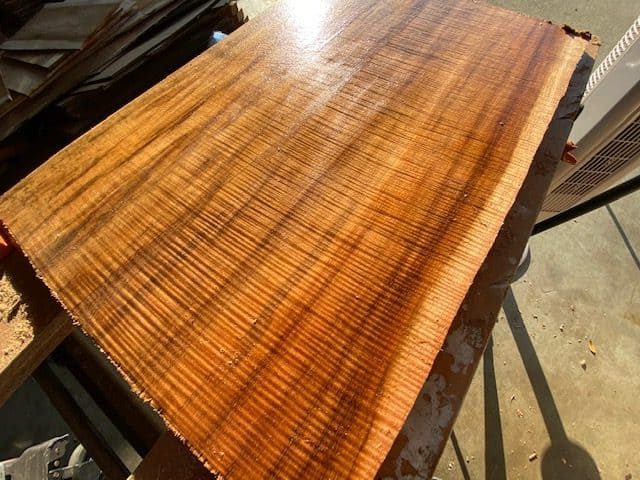
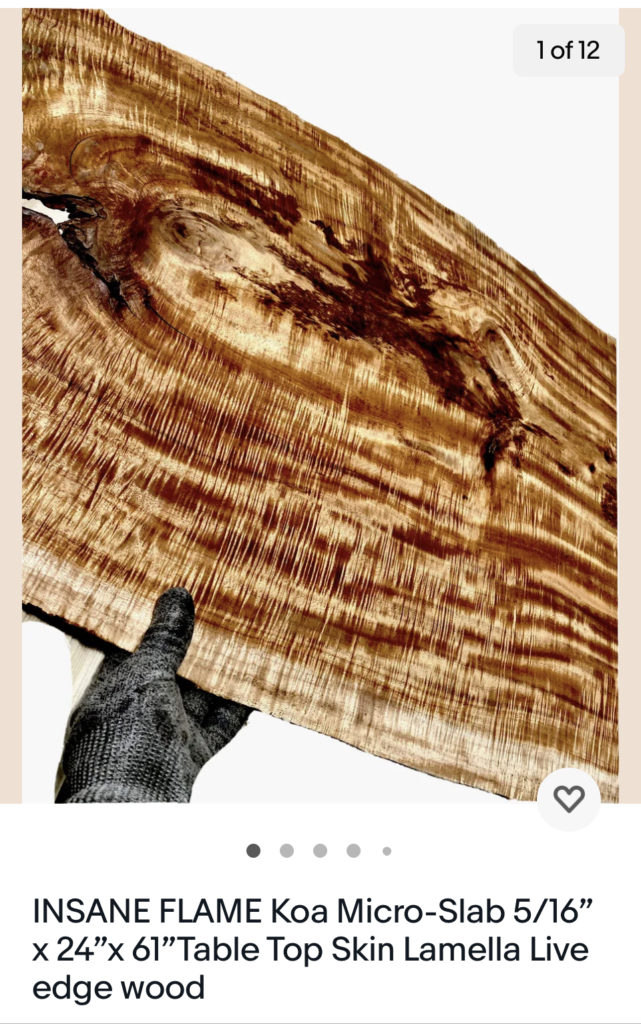

Pingback: Ebony Lumber: Macassar Ebony Wood - Commercial Forest Products
Pingback: Chatoyancy - What is Chatoyance in Figured Wood? - Commercial Forest Products
Pingback: Quartersawn Maple: A Helpful Illustrated Guide to Hardwood - 2019 🌳
Pingback: EASY Lumber Weight 101: How Much Does Lumber Weigh? - Commercial Forest Products